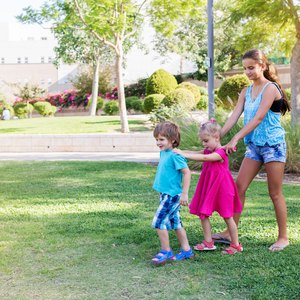
Whether a baby sitter is entitled to tax deductions for her child-care activities depends on how the baby sitter's employment is classified. Some families may consider a baby sitter to be a household employee, while other families may not consider employment statuses and just pay sitters without reporting it to the Internal Revenue Service.
Employee or Self-Employed
Baby sitters can either be considered employees or self-employed people, depending on how much control the person who hires the baby sitter has over the sitter's work and working conditions. An employer will have direct control over the work the baby sitter does and how she does it; in this instance, the baby sitter is an employee. If the family does not have control over these aspects of the baby sitter's job, the sitter is self-employed. As an employee, the baby sitter may have Social Security and Medicare taxes withheld from her pay and is not entitled to any deductions related to the baby-sitting. However, if the sitter is self-employed, she is entitled to deduct expenses related to her child-care income.
Schedule C
Self-employed baby sitters report income and expenses related to child-care income on IRS Schedule C and attach this schedule to their Form 1040 personal income tax returns. For the 2018 tax year, the IRS has updated the Form 1040, Form 1040-A and Form 1040-E to a combined form that is a shorter and simplier.
A baby sitter may receive a Form 1099-MISC from the family he baby-sits for if paid more than $600 from any one family in a single year; it lists the amount of income he earned during the year. However, even if this form is not received, the baby sitter must still report the income he made to the IRS.
Common Deductions
Common deductions for self-employed sitters include a per-mile deduction for the miles they drive to and from sitting jobs, for driving the children to activities and for picking them up or dropping them off at requested locations. Sitters can also deduct supplies they purchase for baby-sitting jobs, such as arts and crafts supplies, stickers and prizes. Deductions for business cards, advertising and first-aid certifications are also allowed. Essentially, if a self-employed baby sitter has expenses related directly to the income earned from sitting jobs, expenses related to getting jobs or expenses related to enhancing her baby-sitting skills, the costs are deductible.
Self-Employment Tax
One tax that may catch a self-employed babysitter by surprise is the IRS self-employment tax. This tax is charged as a replacement for the Social Security and Medicare taxes that are usually paid by the sitter and his employer when the baby sitter is considered a household employee. Self-employed baby sitters pay this entire tax, along with income tax, on the net profits earned from sitting – not the gross amount earned. Net profit equals the baby sitter's income, minus deductions. However, when a sitter is subject to self-employment tax, he can also take a separate deduction for one-half the amount from his adjusted gross income directly on the 1040 form.
References
Writer Bio
With a background in taxation and financial consulting, Alia Nikolakopulos has over a decade of experience resolving tax and finance issues. She is an IRS Enrolled Agent and has been a writer for these topics since 2010. Nikolakopulos is pursuing Bachelor of Science in accounting at the Metropolitan State University of Denver.

